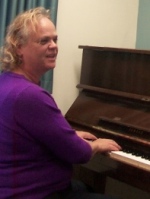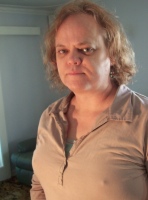
Mix Margaret Dylan Jones
W.A. composer, pianist,
teacher, article writer, lyricist
for a wide range of musical styles
Learning About The Voice
A great many experiences and studies have gone into my teaching technique for speech and singing, but my real strength lies in being able to put it all together in analysing your voice.
For decades I was a masterclass junkie, either attending or participating in every opportunity I could find to learn more about singing and how the voice works (and piano & composition etc). Every now and then I recall another workshop or performance where I found some new pearl of wisdom. For example, a vocal health seminar by a speech pathologist, or a singing masterclass by a visiting world-class performer such as Jane Manning.
Would I recommend you become a masterclass junkie like me? Absolutely. On one hand, all that information, some of it contradictory, could be confusing and you'll need good judgement to know what to use and how to use it. On the other hand, the sooner you start developing that good judgement, the sooner you'll have it.
One piece of advice: there is considerable confusion about terminology, and many teachers use vague and imprecise language, and all sorts of weird and wonderful imagery. Try to stick to the facts and get to the heart of the matter. Imagery is certainly very important and I use it with my students, but please don't talk about 'singing from your stomach' or 'breathing into your stomach'. Think about it--your voice starts in your larynx and if you get air in your stomach you'll be burping, not singing. If you're a teacher, say what you mean and mean what you say, otherwise your students will be confused.
Jo Estill
Nearly 30 years ago, in the late 1980s, I first learnt some of the vocal control manoeuvres developed by Jo Estill. I did this through being a 'guinea pig' myself in one of Estill's workshops in Perth and attending her other classes.
Estill was a successful opera singer before becoming a major figure in voice science. She then developed a very detailed approach to vocal pedagogy that identified the precise muscular requirements for each singing style and put the various manoeuvres together in different combinations as a kind of 'style recipe cookbook'.
She called the six basic voice qualities speech, falsetto, sob/cry, twang (two types), opera, and belting. Note that speech quality singing has no relation to speech level singing (it's a completely different idea, see below), and belt is also known as Broadway belt. Belt is used by singers in many styles other than 'Broadway' or musical theatre.
Nasal Endoscopy
In 1990 I went to a weekend workshop on Estill's techniques run in Adelaide by another singing teacher (Helen Tiller) and a speech pathologist (Alison Bagnall). A 16 minute video of my own vocal folds in motion was made at the workshop. They had put a video camera up my nose and down the other side!
Extra Estill Study
And in 1997/98 I did six months of extra study and revision in Estill's work with Ros Barnes, an accredited teacher of the Estill method. (Note, however, that I am NOT an Estill teacher.)
Choirs: A Very Tricky Situation
Of course, in my early days doing a Bachelor of Music (composition) at the University of Western Australia I sang in all the choirs around the place. I had the great privilege to work under many wonderful choral conductors, such as Rodney Eichenberger and Margaret Pride. Decades ago I was one of the first three or four people in Western Australia to join the Australian Choral Conductors' Association, before it became the Australian National Choral Association (ANCA).
In 1989 I founded the Perth Discovery Choir and conducted it for five years, and in 2001 I founded and conducted Girls, Guys & Others: the GGO Quire (I was one of the 'others'). All the singers in these adult community choirs had a few individual lessons with me so I could fully understand each voice and know how to properly assign them to their vocal roles (such as high, low, medium). This also helped me develop my approach to vocal blending, so important in choirs.
This has given me a detailed understanding of the important differences between choral and solo singing, and how to manage this complex situation. I remember times when undergraduate singing students were forbidden to sing in choirs because it was seriously affecting their voices, whilst choral singing was compulsory for their instrumental classmates. (I have some special techniques for choral singing which I don't usually teach to my solo singing students, unless they are also in a choir.)
The Most Important Learning Experience Of All
In the mid-1980s while still singing in choirs at Uni I lost my voice. I was completely mute, speechless. This lead me to have six weeks of speech therapy (with Thea Peterson). Now THAT was a useful experience. I draw on what I learnt there every day.
In retrospect it was easy to see why I lost my voice. It was due to several factors which had existed for a long time but which had not previously all occurred simultaneously, plus some new things happening around the same time which became the 'straw that broke the camel's back'. This experience really helped me understand how the voice (singing and speaking) really works, how to put it all together, what the danger signs are, and how to avoid progressing to full-blown dysphonia.
ANATS committee, seminars
In the mid to late 1980s the Australian National Association of Teachers of Singing was forming, and I became the Secretary/Treasurer of the WA Chapter (taking over from the wonderful singer, Megan Sutton). In that year I helped to organise several events for our members and their students. Over the years I have attended (and in the early years helped to organise) many ANATS presentations from speech pathologists, an ENT specialist, language teachers, and many others.
Private Study & A Fresh One
On my own I have spent countless hours pouring over (as in really studying) many important voice textbooks. I have studied countless videos and diagrams of the larynx. Once, a student who was a nurse at RPH, a teaching hospital, arranged for us both to view a collection of a dozen diseased larynxes kept in jars. While we were looking at them the people in charge wheeled in a 'fresh one'. Use your imagination! Using the surgical gloves they supplied us with we dug around looking all through the vocal mechanism, trying to find the actual vocal folds. We couldn't see them, even though the whole vocal tract had been cut open. It seems you need to have a 'live' one to see them because they really are folds, like folds of skin, and they retract and disappear post mortem.
Seth Riggs
A couple of ideas have been borrowed from the American teacher, Seth Riggs. From his book and CD I learnt about speech level singing, explained in a clearer way than I had encountered previously (this has nothing to do with another important concept, 'speech quality singing'). He also has a very useful technique for smoothing out the register breaks. It works like a treat, though like any technique you can do it wrong and suffer the consequences. Tip: never do the lip roll without using your fingers to push the cheek muscles around your mouth or lips in onto the jaw or teeth, to disable those muscles. If you do it without the fingers it creates great tension in the mouth and jaw that you seriously don't want. And don't do the lip roll if your vocal folds are not in good health. Of course, I am not a "Seth Riggs teacher."
My Singing Teachers
I didn't start to learn solo singing until I landed a 22 hours-a-week job playing piano for singing lessons in Sydney around 1984. After a week or so listening to Jean Callaghan giving tuition to her many pupils, I was so impressed that I asked if I could learn, too. In 1985 I moved back to Perth and to date I've had regular lessons with six wonderful singing teachers.
I haven't pursued a career in singing, though I did take out a number of first places in a local singing competition, the Fremantle Eisteddfod, in 1992. (These days I'm more focused on composing and playing classical piano, and teaching piano, singing and music theory.)
Languages
At high school (a very long time ago, back in last century) I took German for my TAE (year 12 exams). And I did a year of French in what we called "First Year". When I took up learning to sing, in 1984, my first teacher was absolutely brilliant at German and Italian, so that's what I learnt for 18 months. After I returned to Perth in 1985 I studied Italian 110 (i.e. for beginners) at the Uni of WA. Along the way I have had a few formal lessons in Putonghua (Mandarin Chinese) and Bahasa Indonesia. And, of course, I also teach singing in Latin.
This means I can teach singing in English, German, Italian and Latin. I will teach in French and other languages provided the student is already fluent in that language.
facebook.com/MixMargaretDylanJones
www.mixmargaret.com/blog

Online Vocal Resources
Professional Services
All about Margaret
My sites
PIANO PAGES HOME
SINGING SITE HOME
RESOURCE REVIEWS HOME
Combined Entry Portal
Site List